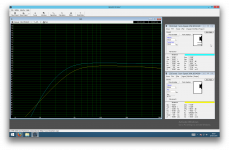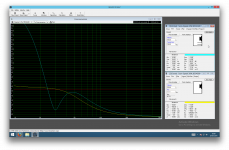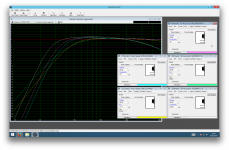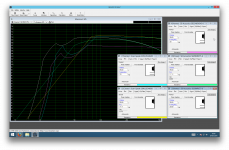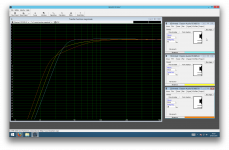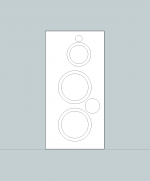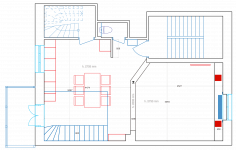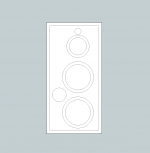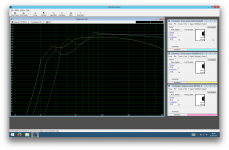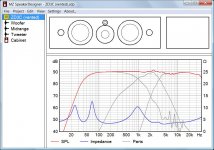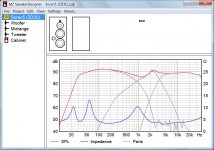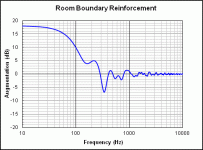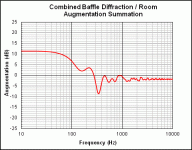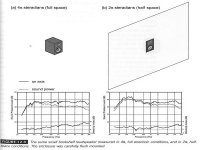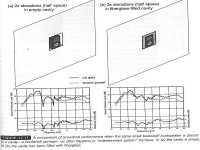Perhaps I’m not explaining myself well enough, but I’m not looking for a mediocre system. And maybe I don’t have the necessary experience to create a better than mediocre system, but that’s why I come here for help. I’m interested in building the loudspeakers myself and not simply purchasing a cheap 2.1 system and be done with it.Then fill the space with a simple 2.1 system. It doesn't make any sense to put a large amount of money on a mediocre system, if you don't have the necessary ability and experience to create a good solution. A 3-way is much more complex than a 2-way, and you have also some constraints on top of that.
Yes, I have explained my friend that bookshelf placement is not ideal for speakers, and he is aware of that. Failure is of course a possibility, but with my own experience in loudspeaker design combined with the help from both literature and other members of e.g. diyAudio, I am confident and positive that I will succeed.But, again, the primary objective is really shared with your friend? What happens if the speaker won't sound good? You should take in consideration the fact that you could not succeed in designing a good sounding speaker. In other words, a failure can easily happen and you are blamed for the not good sounding speaker built into that beautiful and unmovable piece of furniture.
So what exactly was your advice? Going back through the thread I see only two suggestions from you: 1) free-standing tower speakers, and 2) Zaph’s ZA-SR71 with reduced BSC and placed on top of the bookshelf. Both of these suggestions disregard the design criteria to have the speakers placed inside the bookshelf. Don’t get me wrong here, I’m not saying I don’t appreciate your input, but don’t tell me I only want to listen to what I want to hear. I will consider all advice that respects the criteria described.I gave you my advice, but you don't want to listen. It is quite normal to only listen to what one wants to hear, but a wise person should realize a mistake, and understand if he is up to the task. I don't think that the project is not doable, but is for an experienced designer.
I understand you advise against making my own design. I am also skeptical about this approach, and that is why I was originally looking for a proven design. Since it seems to be difficult to find, perhaps I could take an existing design and adjust it for the unusual placement of the speakers. Before starting this thread I was looking at the 3-way SB 23/3 design made by the German DIY speaker guru Udo Wohlgemuth. As far as I understand this design was made to be placed near the back wall. What do you think about purchasing this design and adjusting the XO accordingly?
SB Acoustics are good value drivers but this design probably has insufficient output at low frequencies for your room. Consider the "standard" SPL level of about 85dB average with peaks of around 20 dB. This is about the level in a cinema, the monitoring level in a studio and about the level to hear a "correct" tonal balance. One can argue +/- 5dB so it is only to get a feel. In your room the listening distance is perhaps 4m. If you compare the ported response of the SB Acoustic 8" and the 10" you will see the former has a significantly lower SPL because of the cone area but also exceeds the linear excursion limit over much of the range below 80Hz. The 10" is substantial better in this respect and approaches the required SPL to handle peaks cleanly.Before starting this thread I was looking at the 3-way SB 23/3 design made by the German DIY speaker guru Udo Wohlgemuth. As far as I understand this design was made to be placed near the back wall. What do you think about purchasing this design and adjusting the XO accordingly?
Good point! I did some sims for the Scan-Speak 10'' 26W/8534G00 in a 55L sealed enclosure. Attached you can see it compared to the 8” 22W/8534G00 in a 55L vented enclosure. It seems that I would get better SPL and lower extension for the 8” vented compared to the 10” sealedSB Acoustics are good value drivers but this design probably has insufficient output at low frequencies for your room. Consider the "standard" SPL level of about 85dB average with peaks of around 20 dB. This is about the level in a cinema, the monitoring level in a studio and about the level to hear a "correct" tonal balance. One can argue +/- 5dB so it is only to get a feel. In your room the listening distance is perhaps 4m. If you compare the ported response of the SB Acoustic 8" and the 10" you will see the former has a significantly lower SPL because of the cone area but also exceeds the linear excursion limit over much of the range below 80Hz. The 10" is substantial better in this respect and approaches the required SPL to handle peaks cleanly.
Attachments
Look at the maximum SPL plot for your ported 8" SB and the sealed 10" SS. Now look at the ported 10" SB (SB29NRX) which you may have to add. This is the point I was trying to make earlier about the benefits a more expensive 10" driver may bring. Not extending to lower frequencies but being able to cleanly play the low frequencies the small signal transfer function shows.Good point! I did some sims for the Scan-Speak 10'' 26W/8534G00 in a 55L sealed enclosure. Attached you can see it compared to the 8” 22W/8534G00 in a 55L vented enclosure. It seems that I would get better SPL and lower extension for the 8” vented compared to the 10” sealedBoth drivers are shown at 20W input. What would the benefit be of the 10” driver besides the greater power handling?
Hi,
What part of the ZD3C design do people not understand ?
A mid treble design axis 12" above the tweeter with the
tweeter above the mid unit - that sounds good to me.
Reduced BSC should help it survive in that location and
tone controls used modestly can tweak the bass balance.
There will be some inevitable cavity effects from the
adjoining units, but you can't design / predict for that.
I'd also use just one port, tuned lower, to say 33Hz
to go lower and increase the bass droop somewhat.
I'd offset the drivers and put the port between them.
A rather wacky idea would be to build boxes to fit
in each hole about 1cm less all round and then
line the hole with 1 cm foam with stiffer stuff
on the bottom of the hole to take the weight.
The boxes would not have to look pretty.
Its not half as daft as it may first seem, you'd
be decoupling all the large structure issues.
Regarding the 2cm issue, build grill frames 2cm
thick but extensively bevel the inside edges and
add a 1cm bevel to the outside front edges.
Recess the baffle 1cm in the hole.
(Is it really 2cm ? It seems a lot for a 2" ...)
rgds, sreten.
YMMV but short of measuring drivers in the
actual holes is hard to predict more. With
straight ahead speakers you need wide
horizontal dispersion, the SD3C excels,
and has the right control of vertical.
What part of the ZD3C design do people not understand ?
A mid treble design axis 12" above the tweeter with the
tweeter above the mid unit - that sounds good to me.
Reduced BSC should help it survive in that location and
tone controls used modestly can tweak the bass balance.
There will be some inevitable cavity effects from the
adjoining units, but you can't design / predict for that.
I'd also use just one port, tuned lower, to say 33Hz
to go lower and increase the bass droop somewhat.
I'd offset the drivers and put the port between them.
A rather wacky idea would be to build boxes to fit
in each hole about 1cm less all round and then
line the hole with 1 cm foam with stiffer stuff
on the bottom of the hole to take the weight.
The boxes would not have to look pretty.
Its not half as daft as it may first seem, you'd
be decoupling all the large structure issues.
Regarding the 2cm issue, build grill frames 2cm
thick but extensively bevel the inside edges and
add a 1cm bevel to the outside front edges.
Recess the baffle 1cm in the hole.
(Is it really 2cm ? It seems a lot for a 2" ...)
rgds, sreten.
YMMV but short of measuring drivers in the
actual holes is hard to predict more. With
straight ahead speakers you need wide
horizontal dispersion, the SD3C excels,
and has the right control of vertical.
Last edited:
Right, I think I understand your point now. Here are the max SPL and transfer function sims of the 8” SS ported, the 10” SS sealed, the 8” SB ported, the 10” SB sealed, and finally the 10” SB ported. All cabinet volumes are 55 litres. The most expensive of the four, the 10” SB, also seems to be the one that plays the loudest and goes the deepest.Look at the maximum SPL plot for your ported 8" SB and the sealed 10" SS. Now look at the ported 10" SB (SB29NRX) which you may have to add. This is the point I was trying to make earlier about the benefits a more expensive 10" driver may bring. Not extending to lower frequencies but being able to cleanly play the low frequencies the small signal transfer function shows.
Attachments
Hi,
Obsessing on bass is a great way to build a bad loudspeaker.
It only matters when everything else is very good to excellent.
Don't do it building anything for somebody else, be sensible.
rgds, sreten.
Don't get me wrong, I like good bass, but I'm pragmatic
about what matters and what is reasonable in context.
If you lose the big picture, you are not going to do well.
Loudest and deepest in a sim doesn't tell you anything,
compared to actual reality, sims don't do large signal.
Obsessing on bass is a great way to build a bad loudspeaker.
It only matters when everything else is very good to excellent.
Don't do it building anything for somebody else, be sensible.
rgds, sreten.
Don't get me wrong, I like good bass, but I'm pragmatic
about what matters and what is reasonable in context.
If you lose the big picture, you are not going to do well.
Loudest and deepest in a sim doesn't tell you anything,
compared to actual reality, sims don't do large signal.
Last edited:
I thought the ZD3C looked great. You also seem to know what you’re talking about. I think they could work well for this project.What part of the ZD3C design do people not understand ?
A mid treble design axis 12" above the tweeter with the
tweeter above the mid unit - that sounds good to me.
Reduced BSC should help it survive in that location and
tone controls used modestly can tweak the bass balance.
Isn’t 33Hz too low a tuning for these drivers? Or is that because of the in-bookshelf placement? I’ve attached a quick sim of the two RS180S-8 in a ported 55 litre enclosure tuned to 40, 35, and 30Hz.I'd also use just one port, tuned lower, to say 33Hz
to go lower and increase the bass droop somewhat.
I'd offset the drivers and put the port between them.
Also, may I ask why you want to offset the woofers and place the port between them? I don’t have much space on the baffle, and I don’t think I should move the upper woofer closer to the mid? It could look something like the attached drawing.
I like it this idea!A rather wacky idea would be to build boxes to fit
in each hole about 1cm less all round and then
line the hole with 1 cm foam with stiffer stuff
on the bottom of the hole to take the weight.
The boxes would not have to look pretty.
Its not half as daft as it may first seem, you'd
be decoupling all the large structure issues.
17mm to be exact. I guess I could make the grille frames out of 19mm MDF then. I will get back with some 3D drawings later to make sure I’ve understood your suggestions for beveling the edges.Regarding the 2cm issue, build grill frames 2cm
thick but extensively bevel the inside edges and
add a 1cm bevel to the outside front edges.
Recess the baffle 1cm in the hole.
(Is it really 2cm ? It seems a lot for a 2" ...)
Attachments
Hi,
Basically line up the bass drivers with the mid/treble
or so and move the port to the left in your drawing,
for the left speaker, right would be mirror imaged.
Due to the grille you'll probably need to move the
T&M down somewhat to give room for the bevels.
There is no issue moving the drivers closer together.
Port tuning is an art in itself. What are the 3 major
room mode frequencies L&W&H of the intended room ?
Very often the square root of M1xM2 works well.
Sometimes you just tune low, below M1 if it works.
LxWxH of the room majorly affects bass response.
The placement here will exacerbate L and H, W less so.
rgds, sreten.
Basically line up the bass drivers with the mid/treble
or so and move the port to the left in your drawing,
for the left speaker, right would be mirror imaged.
Due to the grille you'll probably need to move the
T&M down somewhat to give room for the bevels.
There is no issue moving the drivers closer together.
Port tuning is an art in itself. What are the 3 major
room mode frequencies L&W&H of the intended room ?
Very often the square root of M1xM2 works well.
Sometimes you just tune low, below M1 if it works.
LxWxH of the room majorly affects bass response.
The placement here will exacerbate L and H, W less so.
rgds, sreten.
Last edited:
Basically line up the bass drivers with the mid/treble
or so and move the port to the left in your drawing,
for the left speaker, right would be mirror imaged.
Due to the grille you'll probably need to move the
T&M down somewhat to give room for the bevels.
There is no issue moving the drivers closer together.
I haven’t moved the drivers closer together in the attached drawing, just moved all drivers slightly down. Should I move the MT closer to the woofers, and perhaps the woofers closer together? By the way, what would you say is the minimum port diameter if using one port?
Port tuning is an art in itself. What are the 3 major
room mode frequencies L&W&H of the intended room ?
Very often the square root of M1xM2 works well.
Sometimes you just tune low, below M1 if it works.
LxWxH of the room majorly affects bass response.
The placement here will exacerbate L and H, W less so.
Not sure what you mean by the three major room modes. The LxWxH of the room is 9.26 x 4.06 x 2.73 m. I’ve attached the floor plan of the living room and kitchen, which is one open space. The ‘wall’ between the two rooms has been replaced by a ceiling beam. The loudspeakers position are marked with red squares.
Attachments
Why? Is there sufficient output for the room? In your location what are you going to do with 2 midwoofers crossing to a tiny upper midrange? The high crossover means you probably do not want both midwoofers firing together because of lobing but the wall+floor location means your "baffle step correction" would progressively turn off the lower midwoofer and not on. Is that a wise thing to be doing?I think they could work well for this project.
Why?
It’s a well-documented proven design with a XO that's sort of tuned for the position of the speakers. As much as I’m tempted to try a 10” 3-way on my own, I guess sreten has a point about being more sensible and use an existing design, especially when doing something for a friend.
Is there sufficient output for the room? In your location what are you going to do with 2 midwoofers crossing to a tiny upper midrange?
I don’t know if there is sufficient output, but Zaph says the ZDT3 is meant for medium to large rooms. The 2 x 7” Daytons have a total volume displacement of 150cm3 compared to the SS 10” at 210 cm3, and the SB 10” 340 cm3. In terms of max SPL, I have made the attached sim, which shows max output of the three drivers.
Also, the room is actually a little smaller than I initially thought. There are 43m2 and 2.7m to the ceiling.
The high crossover means you probably do not want both midwoofers firing together because of lobing but the wall+floor location means your "baffle step correction" would progressively turn off the lower midwoofer and not on. Is that a wise thing to be doing?
These are some concerns that goes beyond my knowledge. Perhaps sreten can comment on this?
Attachments
The quality of Zaph's ZD3C design is arguable because of the high crossover frequency of 950 Hz, but it certainly requires the original baffle layout. The design is not an option for you as it doesn't work in a different (or infinite) baffle. Two woofers operating up to 1 kHz in combination with an off axis listening position is not a good idea after all.
A single woofer and a 5" midrange crossed at 400-500 Hz is the right way to go IMO.
A single woofer and a 5" midrange crossed at 400-500 Hz is the right way to go IMO.
Attachments
If there was an existing design that was suitable for your location and room then using it would indeed be a low risk choice. The Zaph design is for a speaker placed out in the room with a particular size of baffle. I suspect most would agree that it is a competent design. When you change both the baffle size and the room location you are changing the assumptions made in designing that speaker. It is no longer an existing design.It’s a well-documented proven design with a XO that's sort of tuned for the position of the speakers. As much as I’m tempted to try a 10” 3-way on my own, I guess sreten has a point about being more sensible and use an existing design, especially when doing something for a friend.
In order to adapt an existing design for your purposes it may be wise to understand what needs to be changed and how this affects the original design choices. This knowledge should also help you spot the more appropriate existing designs to adapt. There is obviously more risk if you simply follow peoples suggestions without this knowledge.
On a more positive note what is the worst that can happen? You will end up with a speaker that is not as good as it might have been. If in doubt it may be wise to adapt conventional designs (i.e. ported with a 1" tweeter, 4"-5" midrange, and a 8"-10" woofer) like the two you linked to earlier.
Alright, thanks for the input Dissi and Andy. I guess It’s kind of back to the drawing board then 
In my search for potential drivers I had another look at SB Acoustics. I’m familiar with their drivers as I have previously built Jeff Bagby’s Piccolo Speakers and really like them.
The SB 10” woofer sims better in a smaller vented enclosure compared to the SS 10” previously mentioned in the thread. Here is an idea for an all SB Acoustics 55L ported 3-way:
Tweeter: 1” SB26STCN-C000-4 - 4 ohm - 92.5dB
Midrange: 4’’ SB12MNRX25-4 - 4 ohm - 88.5dB
Woofer: 10'' SB29NRX75-6 - 6 ohm - 88dB
What do you think?
I will get Jeff Bagby’s software up and running and try to do some XO design with the published curves.
In my search for potential drivers I had another look at SB Acoustics. I’m familiar with their drivers as I have previously built Jeff Bagby’s Piccolo Speakers and really like them.
The SB 10” woofer sims better in a smaller vented enclosure compared to the SS 10” previously mentioned in the thread. Here is an idea for an all SB Acoustics 55L ported 3-way:
Tweeter: 1” SB26STCN-C000-4 - 4 ohm - 92.5dB
Midrange: 4’’ SB12MNRX25-4 - 4 ohm - 88.5dB
Woofer: 10'' SB29NRX75-6 - 6 ohm - 88dB
What do you think?
I will get Jeff Bagby’s software up and running and try to do some XO design with the published curves.
Hi,
Proper design and modelling is always going to be better.
Looks like I've underestimated the effect of moving the
drivers apparently, but that would be hard to surmise from
Zaphs plots that the situation would be as bad as implied.
That going from the 3.5 way to the 3 way would have
such an onerous effect on the 800Hz vertical polar plots,
noting the minor differences in the x/o's of the two versions.
If indeed it does some redesign is needed, and your assumptions
for baffle diffraction effects, floor coupling, amount of BSC due
the rear wall etc, need careful consideration, as well as the
the off axis and power responses needed.
Personally I'd say building the bass units into the spaces and
mid/treble satellites sitting on the top near front is an idea,
It has a lot less problems that you have to guesstimate.
rgds, sreten.
http://audio.claub.net/Simple Loudspeaker Design ver2.pdf
FRD Consortium tools guide
http://web.archive.org/web/20090902124715/http://geocities.com/woove99/Spkrbldg/DesigningXO.htm
All your problems start below 1KHz, above that the ZD3C is fine.
I still think the ZD3C M&T drivers are a good idea, due to the
dispersion and above axis characteristics, they are exemplary.
(They naturally tilt up, with the forward M and recessed T.)
The mid can be taken a little lower if you give up on the L/R
acoustic 2nd order highpass and add an inductor to the mix.
You can marry a nice 10" to them, exactly how is a modeling,
ideally measuring exercise, noting the point is to get a good
bass mid integration at the nominally 12" above tweeter axis.
What is the best way to model bass correction seems to be
anybodies guess. Some BSC or simply don't bother worrying
about it - go flat into half space and hope it turns out well.
rgds, sreten.
Proper design and modelling is always going to be better.
Looks like I've underestimated the effect of moving the
drivers apparently, but that would be hard to surmise from
Zaphs plots that the situation would be as bad as implied.
That going from the 3.5 way to the 3 way would have
such an onerous effect on the 800Hz vertical polar plots,
noting the minor differences in the x/o's of the two versions.
If indeed it does some redesign is needed, and your assumptions
for baffle diffraction effects, floor coupling, amount of BSC due
the rear wall etc, need careful consideration, as well as the
the off axis and power responses needed.
Personally I'd say building the bass units into the spaces and
mid/treble satellites sitting on the top near front is an idea,
It has a lot less problems that you have to guesstimate.
rgds, sreten.
http://audio.claub.net/Simple Loudspeaker Design ver2.pdf
FRD Consortium tools guide
http://web.archive.org/web/20090902124715/http://geocities.com/woove99/Spkrbldg/DesigningXO.htm
All your problems start below 1KHz, above that the ZD3C is fine.
I still think the ZD3C M&T drivers are a good idea, due to the
dispersion and above axis characteristics, they are exemplary.
(They naturally tilt up, with the forward M and recessed T.)
The mid can be taken a little lower if you give up on the L/R
acoustic 2nd order highpass and add an inductor to the mix.
You can marry a nice 10" to them, exactly how is a modeling,
ideally measuring exercise, noting the point is to get a good
bass mid integration at the nominally 12" above tweeter axis.
What is the best way to model bass correction seems to be
anybodies guess. Some BSC or simply don't bother worrying
about it - go flat into half space and hope it turns out well.
rgds, sreten.
Last edited:
The SB woofer will produce "better" bass than the SS but is also more expensive. The location will effectively boost the sensitivity but you need to perform some simulations to get a feel for how much and the transition to higher frequencies.Here is an idea for an all SB Acoustics 55L ported 3-way:
Tweeter: 1” SB26STCN-C000-4 - 4 ohm - 92.5dB
Midrange: 4’’ SB12MNRX25-4 - 4 ohm - 88.5dB
Woofer: 10'' SB29NRX75-6 - 6 ohm - 88dB
What do you think?
The sensitivity of the midrange will pull down the sensitivity of the whole speaker. It is not uncommon to use two midranges in this situation (for example) but there are pros and cons and you probably have not got the baffle height. The SS looks more appropriate in this respect.
The suggestion to keep the 0.75" tweeter and 2" upper midrange would be unusual for a 3 way but is common for 4 ways (for example) with, say, a 6.5" lower midrange/upper bass and a 10-12" woofer or multiple 6.5"-8" woofers for a narrow baffle. A 10" woofer with a set of parameters designed to perform well at low frequencies will perform relatively poorly at high frequencies and vice-versa.
I think no matter what speaker you decide on, you are probably going to be best off using some form of eq for this kind of set-up to compensate for either the low end boundary reinforcements or the losses due to the bookshelf's cavity effects.
First 2 charts are some rough estimates of the on-axis boundary effects of your set-up with the center of the driver about 9" off the floor, 32" to the side wall and 15" from the back wall. First chart shows the boundary effects and the 2nd is boundary plus baffle diffraction effects for a 10" woofer (baffle of about 13'W x 26"H x 15"D, ie. the whole bookcase).
But your rendering in your 1st posts looks like the right speaker will be sitting beside something like a covered radiator so even if you fill all the rest of the shelves full and flush to the front edge, you are still going to get some cavity effects occurring with that speaker. See the next couple of charts.
So I'm wondering whether or not there is really going to be that much difference between eq'ing a design that is meant for:
1- free space (say Troel's Classic 3-way), or
2 - a free-space design that has the baffle reconfigured (like Zaph's ZD3C xo on the vertical baffle layout) or the xo slightly changed (ie. without baffle step compensation), or
3 - your own design for this specific space.
That may re-open some possibilities for you. I'm thinking that a receiver that has something like a self measuring AudyssyEQ or similar that does the eq for each speaker separately might work fairly well with any good quality speaker design. Or there are other dsp products out there as well. Even the old analog eq's.
But also note that if designing your own and going without any eq, you need to be careful about your driver sensitivities. If you select an 88dB woofer that doesn't need baffle step compensation but actually gets some amount of dB boost below about 300Hz, then an 88dB mid is not going to be loud enough to match it.
First 2 charts are some rough estimates of the on-axis boundary effects of your set-up with the center of the driver about 9" off the floor, 32" to the side wall and 15" from the back wall. First chart shows the boundary effects and the 2nd is boundary plus baffle diffraction effects for a 10" woofer (baffle of about 13'W x 26"H x 15"D, ie. the whole bookcase).
But your rendering in your 1st posts looks like the right speaker will be sitting beside something like a covered radiator so even if you fill all the rest of the shelves full and flush to the front edge, you are still going to get some cavity effects occurring with that speaker. See the next couple of charts.
So I'm wondering whether or not there is really going to be that much difference between eq'ing a design that is meant for:
1- free space (say Troel's Classic 3-way), or
2 - a free-space design that has the baffle reconfigured (like Zaph's ZD3C xo on the vertical baffle layout) or the xo slightly changed (ie. without baffle step compensation), or
3 - your own design for this specific space.
That may re-open some possibilities for you. I'm thinking that a receiver that has something like a self measuring AudyssyEQ or similar that does the eq for each speaker separately might work fairly well with any good quality speaker design. Or there are other dsp products out there as well. Even the old analog eq's.
But also note that if designing your own and going without any eq, you need to be careful about your driver sensitivities. If you select an 88dB woofer that doesn't need baffle step compensation but actually gets some amount of dB boost below about 300Hz, then an 88dB mid is not going to be loud enough to match it.
Attachments
Hi,
A 2" dome mid is not that unusual in a 3 way
(see Tony Gee's Black box 3way) but is in
some respects better in a 3.5 way.
There are lots of options, including active
bass to mid and passive mid to treble.
The ideal size is probably a 8" unit, but a
10" unit only increases the spacing ~ 1",
so the right sort of 10" driver is usable.
The ZDC with centre layout by definition
has excellent vertical bass to mid lobing.
The problem is getting decent lobing
for an axis above the speaker layout.
A problem I initially underestimated it seems.
rgds, sreten.
A 2" dome mid is not that unusual in a 3 way
(see Tony Gee's Black box 3way) but is in
some respects better in a 3.5 way.
There are lots of options, including active
bass to mid and passive mid to treble.
The ideal size is probably a 8" unit, but a
10" unit only increases the spacing ~ 1",
so the right sort of 10" driver is usable.
The ZDC with centre layout by definition
has excellent vertical bass to mid lobing.
The problem is getting decent lobing
for an axis above the speaker layout.
A problem I initially underestimated it seems.
rgds, sreten.
The SB woofer will produce "better" bass than the SS but is also more expensive. The location will effectively boost the sensitivity but you need to perform some simulations to get a feel for how much and the transition to higher frequencies.
Maybe I should stick with SS drivers but go with the 8” woofer and in a ported design. Good sensitivity and bass extension is okay. Then crossed to the SS mid. I will have to do some more sims, especially now looking at the room boundary reinforcement affects illustrated by jReave.
- Status
- This old topic is closed. If you want to reopen this topic, contact a moderator using the "Report Post" button.
- Home
- Loudspeakers
- Multi-Way
- 3-way for bookshelf (in-wall)
